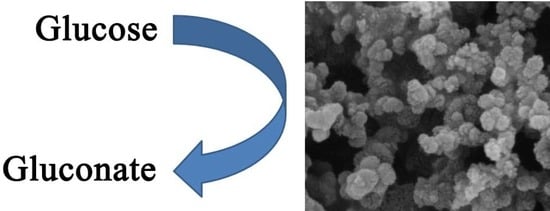Electrocatalytic Glucose Oxidation at Coral-Like Pd/C3N4-C Nanocomposites in Alkaline Media
Abstract
:1. Introduction
2. Results
2.1. Physical Characterization
2.2. Electrochemical Characterization
2.3. Glucose Sensing
3. Materials and Methods
3.1. Materials and Instruments
3.2. Preparation of C3N4 and Pd/C3N4-C
3.3. Electrochemical Experiments of Glucose Sensors and GOR Analysis
4. Conclusions
Author Contributions
Funding
Conflicts of Interest
References
- Heller, A.; Feldman, B. Electrochemical glucose sensors and their applications in diabetes management. Chem. Rev. 2008, 108, 2482–2505. [Google Scholar] [CrossRef] [PubMed] [Green Version]
- Adzic, R.R.; Hsiao, M.W.; Yeager, E.B. Electrochemical oxidation of glucose on single crystal gold surfaces. J. Electroanal. Chem. Interfacial Electrochem. 1989, 260, 475–485. [Google Scholar] [CrossRef]
- Song, S.; Wang, K.; Yan, L.; Brouzgou, A.; Zhang, Y.; Wang, Y.; Tsiakaras, P. Ceria promoted Pd/C catalysts for glucose electrooxidation in alkaline media. Appl. Catal. B Environ. 2015, 176–177, 233–239. [Google Scholar] [CrossRef]
- Brouzgou, A.; Tsiakaras, P. Electrocatalysts for glucose electrooxidation reaction: A Review. Top. Catal. 2015, 58, 1311–1327. [Google Scholar] [CrossRef]
- Wang, Q.; Cui, X.; Chen, J.; Zheng, X.; Liu, C.; Xue, T.; Wang, H.; Jin, Z.; Qiao, L.; Zheng, W. Well-dispersed palladium nanoparticles on graphene oxide as a non-enzymatic glucose sensor. RSC Adv. 2012, 2, 6245–6249. [Google Scholar] [CrossRef]
- Rafaïdeen, T.; Baranton, S.; Coutanceau, C. Highly efficient and selective electrooxidation of glucose and xylose in alkaline medium at carbon supported alloyed PdAu nanocatalysts. Appl. Catal. B Environ. 2019, 243, 641–656. [Google Scholar] [CrossRef]
- Wu, W.; Miao, F.; Tao, B.; Zang, Y.; Zhu, L.; Shi, C.; Chu, P.K. Hybrid ZnO-graphene electrode with palladium nanoparticles on Ni foam and application to self-powered nonenzymatic glucose sensing. RSC Adv. 2019, 9, 12134–12145. [Google Scholar] [CrossRef] [Green Version]
- El-Ads, E.H.; Galal, A.; Atta, N.F. The effect of A-site doping in a strontium palladium perovskite and its applications for non-enzymatic glucose sensing. RSC Adv. 2016, 6, 16183–16196. [Google Scholar] [CrossRef]
- Ni, Z.; Dong, F.; Huang, H.; Zhang, Y. New insights into how Pd nanoparticles influence the photocatalytic oxidation and reduction ability of g-C3N4 nanosheets. Catal. Sci. Technol. 2016, 6, 6448–6458. [Google Scholar] [CrossRef]
- Wu, Y.S.; Wu, Z.W.; Lee, C.L. Concave Pd core/island Pt shell nanoparticles: Synthesis and their promising activities toward neutral glucose oxidation. Sens. Actuators B Chem. 2019, 281, 1–7. [Google Scholar] [CrossRef]
- Ma, J.; Chen, Y.; Chen, L.; Wang, L. Ternary Pd–Ni–P nanoparticle-based nonenzymatic glucose sensor with greatly enhanced sensitivity achieved through active-site engineering. Nano Res. 2017, 10, 2712–2720. [Google Scholar] [CrossRef]
- Ye, J.S.; Chen, C.W.; Lee, C.L. Pd nanocube as non-enzymatic glucose sensor. Sens. Actuators B Chem. 2015, 208, 569–574. [Google Scholar] [CrossRef]
- Ponnusamy, R.; Chakraborty, B.; Rout, C.S. Pd-Doped WO3 Nanostructures as Potential Glucose Sensor with Insight from Electronic Structure Simulations. J. Phys. Chem. B 2018, 122, 2737–2746. [Google Scholar] [CrossRef] [PubMed]
- Yang, C.; Cui, X.; Wang, K.; Cao, Y.; Wang, C.; Hu, X. A non-enzymatic glucose sensor based on Pd-Fe/Ti nanocomposites. Int. J. Electrochem. Sci. 2017, 12, 5492–5502. [Google Scholar] [CrossRef]
- Dhara, K.; Thiagarajan, R.; Nair, B.G.; Thekkedath, G.S.B. Highly sensitive and wide-range nonenzymatic disposable glucose sensor based on a screen printed carbon electrode modified with reduced graphene oxide and Pd-CuO nanoparticles. Microchim. Acta 2015, 182, 2183–2192. [Google Scholar] [CrossRef]
- Li, Y.; Niu, X.; Tang, J.; Lan, M.; Zhao, H. A comparative study of nonenzymatic electrochemical glucose sensors based on Pt-Pd nanotube and nanowire arrays. Electrochim. Acta 2014, 130, 1–8. [Google Scholar] [CrossRef]
- Shen, C.; Su, J.; Li, X.; Luo, J.; Yang, M. Electrochemical sensing platform based on Pd-Au bimetallic cluster for non-enzymatic detection of glucose. Sens. Actuators B Chem. 2015, 209, 695–700. [Google Scholar] [CrossRef]
- Liu, Q.; Tang, Y.; Yang, X.; Wei, M.; Zhang, M. An ultra-low detection limit glucose sensor based on reduced graphene oxide-concave tetrahedral Pd NCs@CuO composite. J. Electrochem. Soc. 2019, 166, B381–B387. [Google Scholar] [CrossRef]
- Vilé, G.; Albani, D.; Nachtegaal, M.; Chen, Z.; Dontsova, D.; Antonietti, M.; López, N.; Pérez-Ramírez, J. A stable single-site palladium catalyst for hydrogenations. Angew. Chemie Int. Ed. 2015, 54, 11265–11269. [Google Scholar] [CrossRef]
- Ye, L.; Liu, J.; Jiang, Z.; Peng, T.; Zan, L. Facets coupling of BiOBr-g-C3N4 composite photocatalyst for enhanced visible-light-driven photocatalytic activity. Appl. Catal. B Environ. 2013, 142–143, 1–7. [Google Scholar] [CrossRef]
- Lv, M.; Li, W.; Liu, H.; Wen, W.; Dong, G.; Liu, J.; Peng, K. Enhancement of the formic acid electrooxidation activity of palladium using graphene/carbon black binary carbon supports. Chin. J. Catal. 2017, 38, 939–947. [Google Scholar] [CrossRef]
- Radmilovic, V.; Gasteiger, H.A.; Ross, P.N. Structure and chemical composition of a supported Pt-Ru electrocatalyst for methanol oxidation. J. Catal. 1995, 154, 98–106. [Google Scholar] [CrossRef] [Green Version]
- Holzwarth, U.; Gibson, N. The Scherrer equation versus the “Debye-Scherrer equation”. Nat. Nanotechnol. 2011, 6, 534. [Google Scholar] [CrossRef] [PubMed]
- Uruş, S.; Çaylar, M.; Karteri, İ. Synthesis of graphene supported bis(diphenylphosphinomethyl)amino ligands and their Pd(II) and Pt(II) complexes: Highly efficient and recoverable nano-catalysts on vitamin K3 production. Chem. Eng. J. 2016, 306, 961–972. [Google Scholar] [CrossRef]
- Wang, C.-H.; Yang, C.-H.; Chang, J.-K. High-selectivity electrochemical non-enzymatic sensors based on graphene/Pd nanocomposites functionalized with designated ionic liquids. Biosens. Bioelectron. 2017, 89, 483–488. [Google Scholar] [CrossRef]
- Elango, G.; Roopan, S.M.; Al-Dhabi, N.A.; Arasu, M.V.; Dhamodaran, K.I.; Elumalai, K. Coir mediated instant synthesis of Ni-Pd nanoparticles and its significance over larvicidal, pesticidal and ovicidal activities. J. Mol. Liq. 2016, 223, 1249–1255. [Google Scholar] [CrossRef]
- Yu, X.; Fan, T.; Chen, W.; Chen, Z.; Dong, Y.; Fan, H.; Fang, W.; Yi, X. Self-hybridized coralloid graphitic carbon nitride deriving from deep eutectic solvent as effective visible light photocatalysts. Carbon N. Y. 2019, 144, 649–658. [Google Scholar] [CrossRef]
- Zhou, C.; Lai, C.; Huang, D.; Zeng, G.; Zhang, C.; Cheng, M.; Hu, L.; Wan, J.; Xiong, W.; Wen, M.; et al. Highly porous carbon nitride by supramolecular preassembly of monomers for photocatalytic removal of sulfamethazine under visible light driven. Appl. Catal. B Environ. 2018, 220, 202–210. [Google Scholar] [CrossRef]
- Li, Y.; Ho, W.; Lv, K.; Zhu, B.; Lee, S.C. Carbon vacancy-induced enhancement of the visible light-driven photocatalytic oxidation of NO over g-C3N4 nanosheets. Appl. Surf. Sci. 2018, 430, 380–389. [Google Scholar] [CrossRef]
- Yan, S.C.; Li, Z.S.; Zou, Z.G. Photodegradation performance of g-C3N4 fabricated by directly heating melamine. Langmuir 2009, 25, 10397–10401. [Google Scholar] [CrossRef]
- Yi, H.; Xia, Y.; Yan, H.; Lu, J. Coating Pd/Al2O3 catalysts with FeOx enhances both activity and selectivity in 1,3-butadiene hydrogenation. Chin. J. Catal. 2017, 38, 1581–1587. [Google Scholar] [CrossRef]
- Darabdhara, G.; Bordoloi, J.; Manna, P.; Das, M.R. Biocompatible bimetallic Au-Ni doped graphitic carbon nitride sheets: A novel peroxidase-mimicking artificial enzyme for rapid and highly sensitive colorimetric detection of glucose. Sens. Actuators B Chem. 2019, 285, 277–290. [Google Scholar] [CrossRef]
- Yang, X.; Tian, L.; Zhao, X.; Tang, H.; Liu, Q.; Li, G. Interfacial optimization of g-C3N4-based Z-scheme heterojunction toward synergistic enhancement of solar-driven photocatalytic oxygen evolution. Appl. Catal. B Environ. 2019, 244, 240–249. [Google Scholar] [CrossRef]
- Yang, Y.; Zhang, C.; Huang, D.; Zeng, G.; Huang, J.; Lai, C.; Zhou, C.; Wang, W.; Guo, H.; Xue, W.; et al. Boron nitride quantum dots decorated ultrathin porous g-C3N4: Intensified exciton dissociation and charge transfer for promoting visible-light-driven molecular oxygen activation. Appl. Catal. B Environ. 2019, 245, 87–99. [Google Scholar] [CrossRef]
- Zhang, W.; Li, X.; Xu, X.; He, Y.; Qiu, F.; Pan, J.; Niu, X. Pd nanoparticle-decorated graphitic C3N4 nanosheets with bifunctional peroxidase mimicking and ON-OFF fluorescence enable naked-eye and fluorescent dual-readout sensing of glucose. J. Mater. Chem. B 2019, 7, 233–239. [Google Scholar] [CrossRef]
- Chen, X.M.; Lin, Z.J.; Chen, D.J.; Jia, T.T.; Cai, Z.M.; Wang, X.R.; Chen, X.; Chen, G.N.; Oyama, M. Nonenzymatic amperometric sensing of glucose by using palladium nanoparticles supported on functional carbon nanotubes. Biosens. Bioelectron. 2010, 25, 1803–1808. [Google Scholar] [CrossRef]
- Singh, B.; Bhardwaj, N.; Jain, V.K.; Bhatia, V. Palladium nanoparticles decorated electrostatically functionalized MWCNTs as a non enzymatic glucose sensor. Sens. Actuators Phys. 2014, 220, 126–133. [Google Scholar] [CrossRef]
- Chen, X.; Li, G.; Zhang, G.; Hou, K.; Pan, H.; Du, M. Self-assembly of palladium nanoparticles on functional TiO2 nanotubes for a nonenzymatic glucose sensor. Mater. Sci. Eng. C 2016, 62, 323–328. [Google Scholar]
- Mao, X.; Yang, X.; Rutledge, G.C.; Alan Hatton, T. Ultra-wide-range electrochemical sensing using continuous electrospun carbon nanofibers with high densities of states. ACS Appl. Mater. Interfaces 2014, 6, 3394–3405. [Google Scholar] [CrossRef]
- Wen, W.; Li, C.; Li, W.; Tian, Y. Carbon-supported Pd-Cr electrocatalysts for the electrooxidation offormic acid that demonstrate high activity and stability. Electrochim. Acta 2013, 109, 201–206. [Google Scholar] [CrossRef]
- Li, W.; Fan, F.R.F.; Bard, A.J. The application of scanning electrochemical microscopy to the discovery of Pd-welectrocatalysts for the oxygen reduction reaction that demonstrate high activity, stability, and methanol tolerance. J. Solid State Electrochem. 2012, 16, 2563–2568. [Google Scholar] [CrossRef]
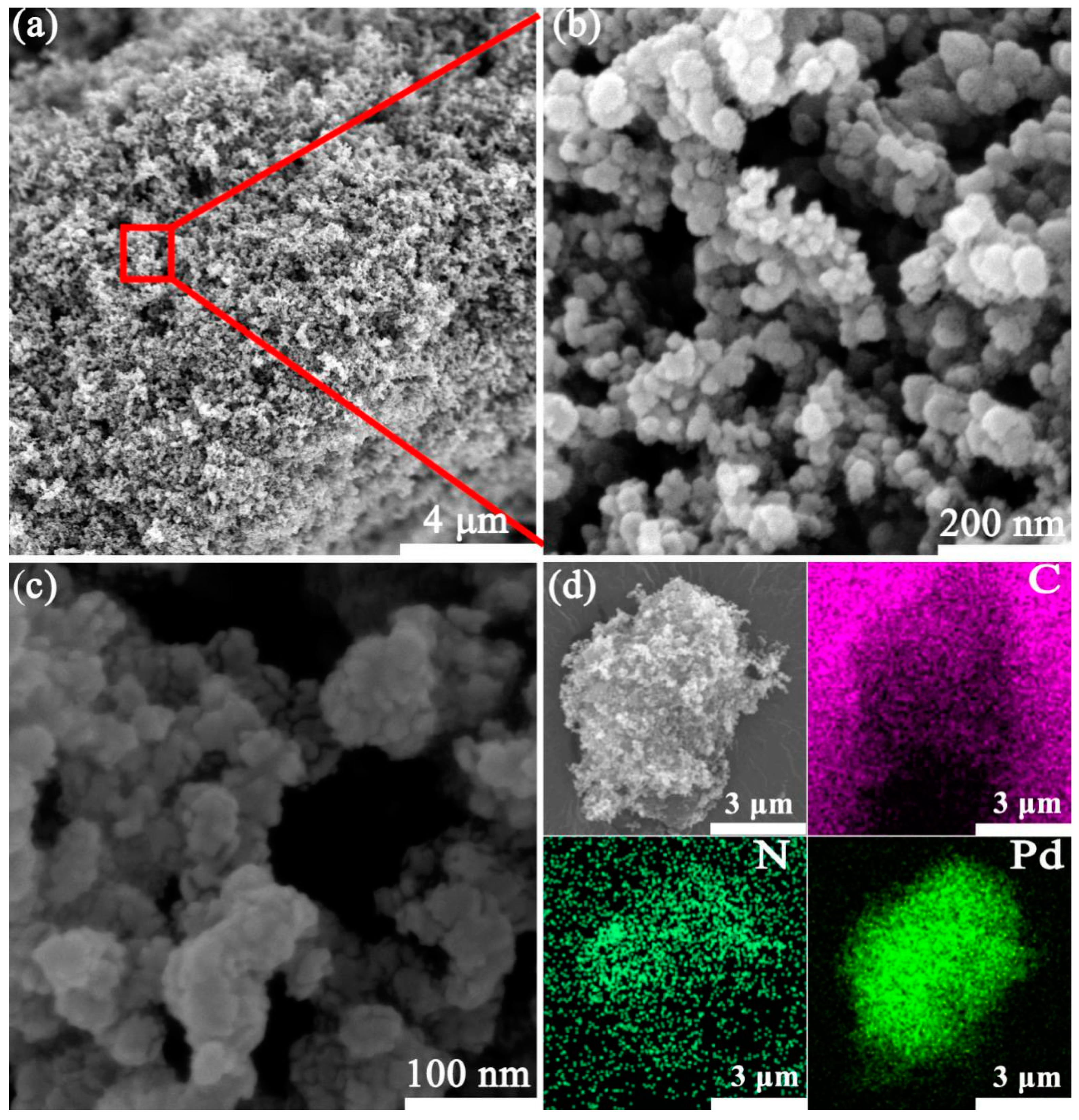
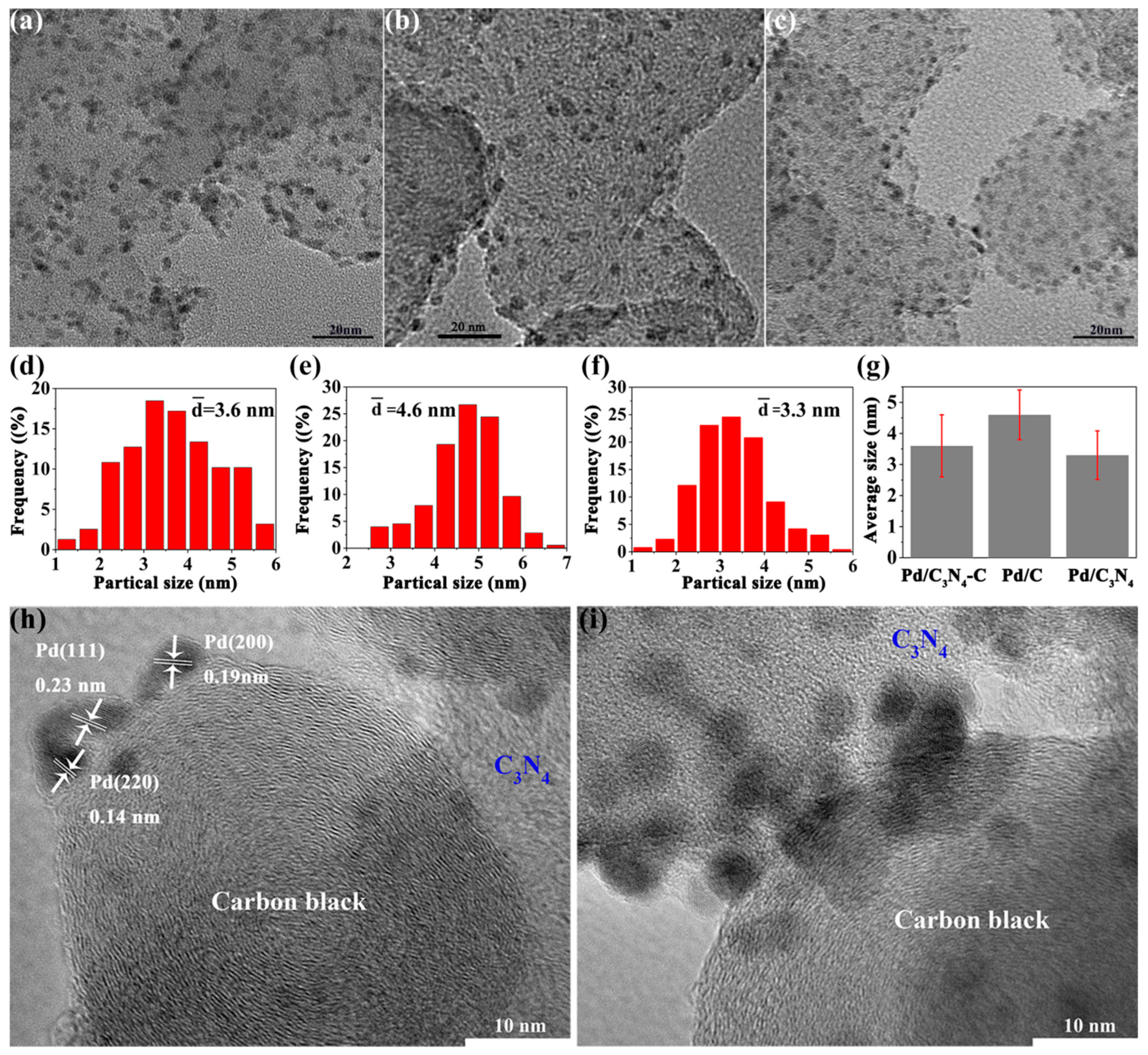
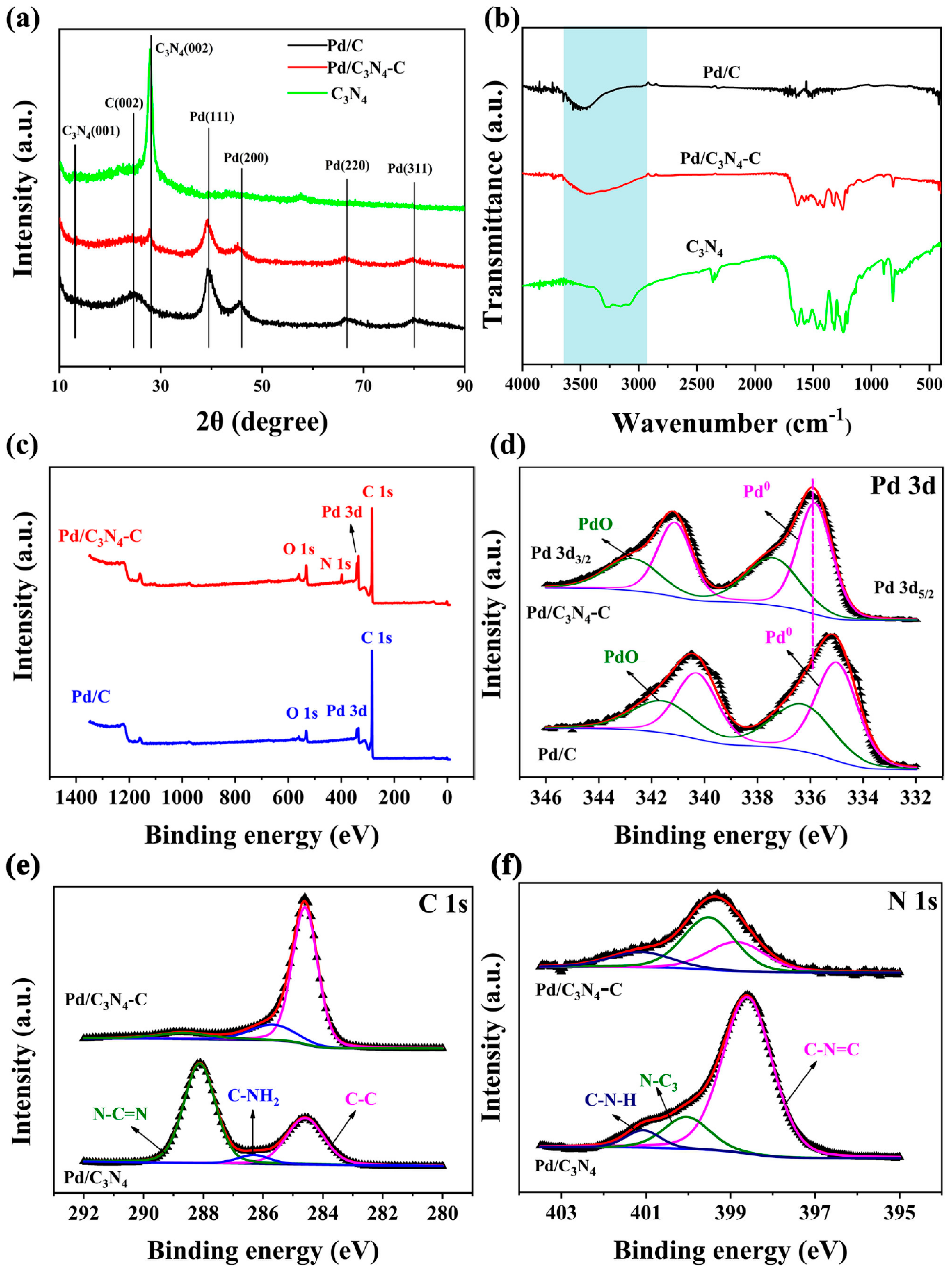
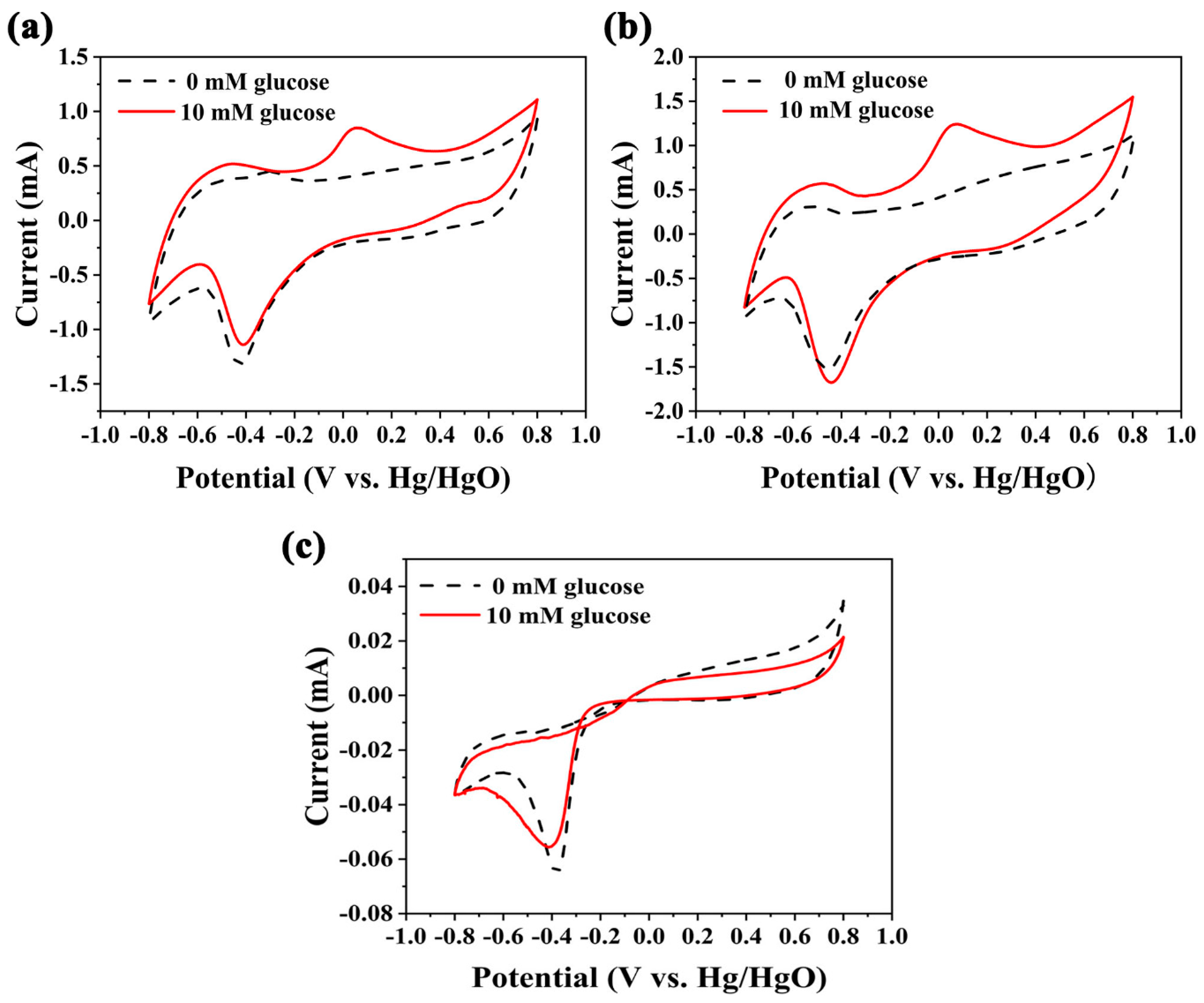

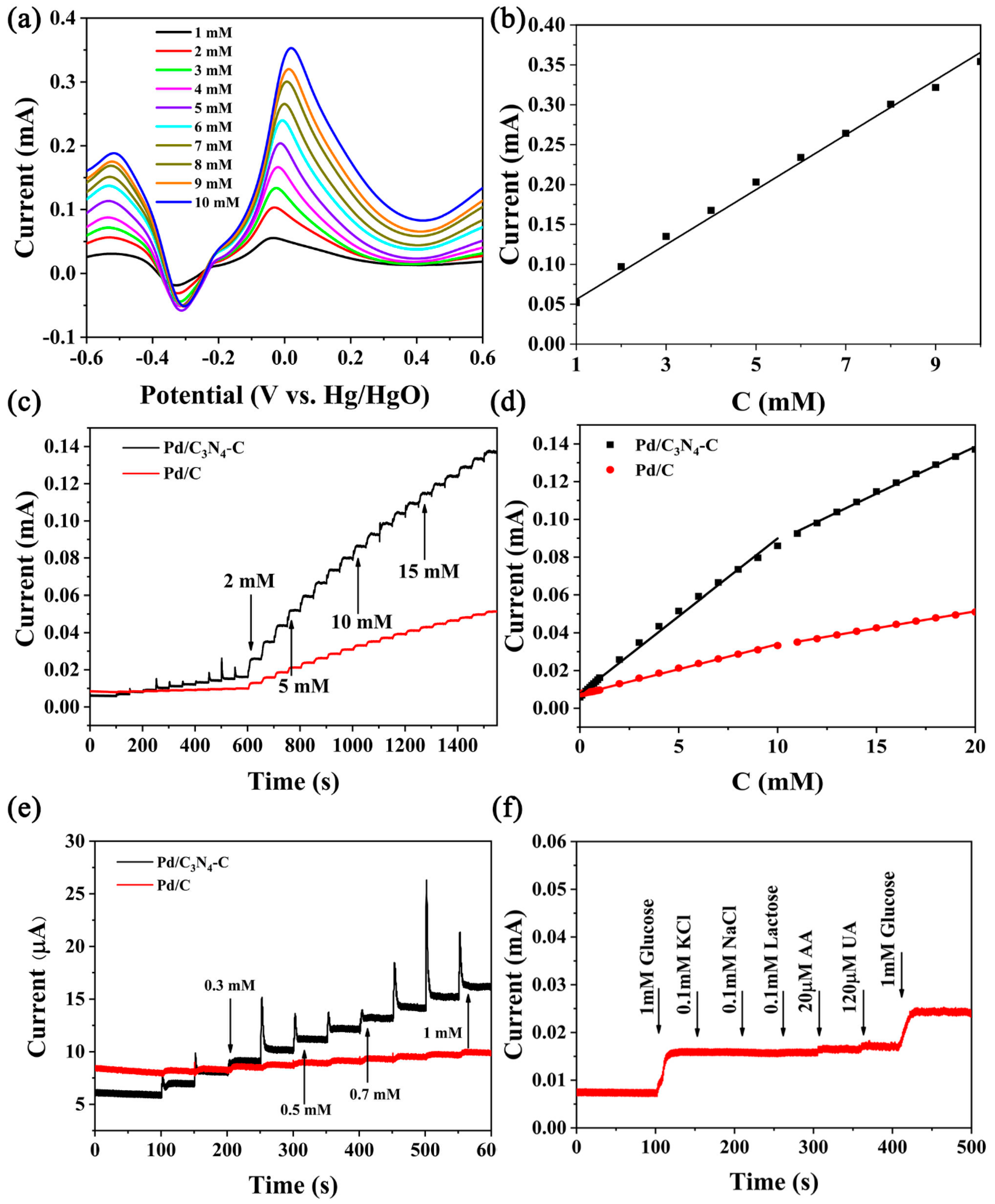
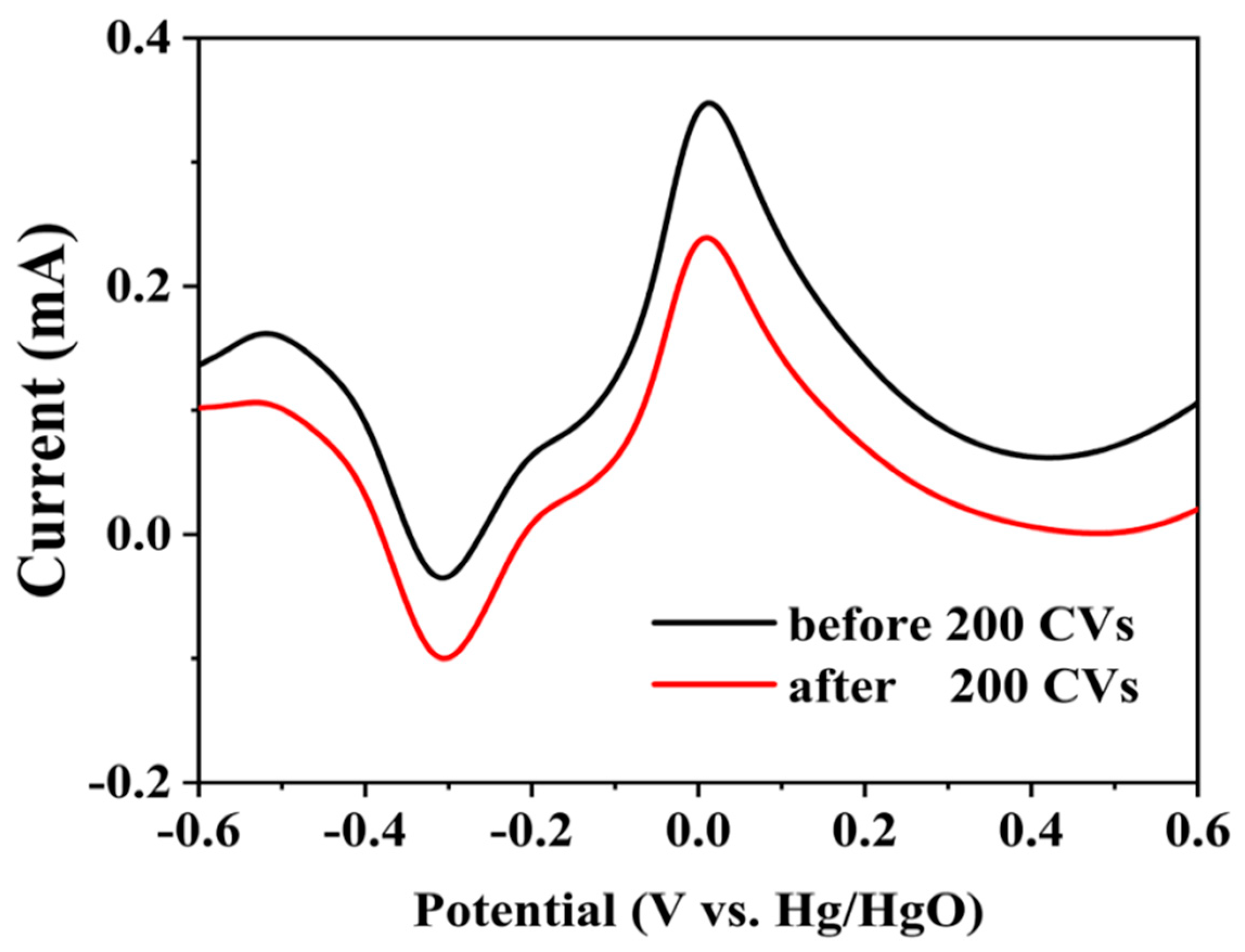

| Electrode | Applied Potential (vs. Hg/HgO) | Linear Range (mM) | LOD (μM) | Reference |
|---|---|---|---|---|
| Pd@Pt CINP/C/GCE 1 | +0.01 V | 1–8.5 | 0.82 | [10] |
| Pd-Ni-P | +0.65 V | 0.005–10.24 | 0.15 | [11] |
| Pd nanocubes | +0.50 V | 1–10 | N/A | [12] |
| WO3-Pd AA 2 | +0.45 V | 5−55, 65−375 | N/A N/A | [13] |
| Pd-Fe/Ti | +0.13 V | 0.002–3.0 | 1.0 | [14] |
| Pd-CuO/rGO/SPE 3 | +0.70 V | 0.006–22 | 0.03 | [15] |
| Pt-Pd nanowire arrays | +0.30 V | Up to 10 | N/A | [16] |
| Pd-Au cluster | +0.04 V | 0.1–30 | 50 | [17] |
| RGO-Pd NCs@CuO 4 | +0.50 V | 0.001–3.1 | 0.01 | [18] |
| Pd/C3N4-C | +0.50 V | 0.1–10 | 0.55 | This work |
| Electrocatalyst | C Specie | eV | Atom % |
|---|---|---|---|
| Pd/C3N4 | C–NH2 | 286.4 | 8.2 |
| - | N–C=N | 288.2 | 58.5 |
| - | C–C | 284.6 | 33.3 |
| Pd/C3N4-C | C-NH2 | 285.7 | 15.5 |
| - | N–C=N | 288.8 | 9.1 |
| - | C–C | 284.6 | 75.4 |
| Electrocatalyst | N Specie | eV | Atom % |
|---|---|---|---|
| Pd/C3N4 | N–C3 | 400.0 | 17.1 |
| - | C–N=C | 398.6 | 76.3 |
| - | C–N–H | 401.1 | 6.7 |
| Pd/C3N4-C | N–C3 | 399.5 | 50.8 |
| - | C–N=C | 398.8 | 31.7 |
| - | C–N–H | 401.1 | 17.5 |
© 2020 by the authors. Licensee MDPI, Basel, Switzerland. This article is an open access article distributed under the terms and conditions of the Creative Commons Attribution (CC BY) license (http://creativecommons.org/licenses/by/4.0/).
Share and Cite
Dong, G.; Lu, Q.; Jiang, H.; Li, C.; Gong, Y.; Zhang, H.; Li, W. Electrocatalytic Glucose Oxidation at Coral-Like Pd/C3N4-C Nanocomposites in Alkaline Media. Catalysts 2020, 10, 440. https://doi.org/10.3390/catal10040440
Dong G, Lu Q, Jiang H, Li C, Gong Y, Zhang H, Li W. Electrocatalytic Glucose Oxidation at Coral-Like Pd/C3N4-C Nanocomposites in Alkaline Media. Catalysts. 2020; 10(4):440. https://doi.org/10.3390/catal10040440
Chicago/Turabian StyleDong, Guang, Qingqing Lu, Haihui Jiang, Chunfang Li, Yingying Gong, Haoquan Zhang, and Wenpeng Li. 2020. "Electrocatalytic Glucose Oxidation at Coral-Like Pd/C3N4-C Nanocomposites in Alkaline Media" Catalysts 10, no. 4: 440. https://doi.org/10.3390/catal10040440
APA StyleDong, G., Lu, Q., Jiang, H., Li, C., Gong, Y., Zhang, H., & Li, W. (2020). Electrocatalytic Glucose Oxidation at Coral-Like Pd/C3N4-C Nanocomposites in Alkaline Media. Catalysts, 10(4), 440. https://doi.org/10.3390/catal10040440




